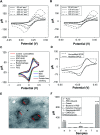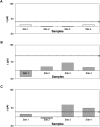A sandwich-type bacteriophage-based amperometric biosensor for the detection of Shiga toxin-producing Escherichia coli serogroups in complex matrices
- PMID: 35517084
- PMCID: PMC9056931
- DOI: 10.1039/d0ra06223e
A sandwich-type bacteriophage-based amperometric biosensor for the detection of Shiga toxin-producing Escherichia coli serogroups in complex matrices
Abstract
Immuno-based biosensors are a popular tool designed for pathogen screening and detection. The current antibody-based biosensors employ direct, indirect, or sandwich detection approaches; however, instability, cross-reactivity, and high-cost render them unreliable and impractical. To circumvent these drawbacks, here we report a portable sandwich-type bacteriophage-based amperometric biosensor, which is highly-specific to various Shiga toxin-producing Escherichia coli (STEC) serogroups. Environmentally isolated and biotinylated bacteriophages were directly immobilized onto a streptavidin-coated screen-printed carbon electrode (SPCE), which recognized and captured viable target cells. Samples (50 μL) were transferred to these bacteriophage-functionalized SPCEs (12 min, room temp) before sequentially adding a bacteriophage-gold nanoparticle solution (20 μL), H2O2 (40 mM), and 1,1'-ferrocenedicarboxylic acid for amperometric tests (100 mV s-1) and analysis (ANOVA and LSD, P < 0.05). The optimum biotin concentration (10 mM) retained 94.47% bacteriophage viability. Non-target bacteria (Listeria monocytogenes and Salmonella Typhimurium) had delta currents below the threshold of a positive detection. With less than 1 h turn-around time, the amperometric biosensor had a detection limit of 10-102 CFU mL-1 for STEC O157, O26, and O179 strains and R 2 values of 0.97, 0.99, and 0.87, respectively, and a similar detection limit was observed in complex matrices, 10-102 CFU g-1 or mL-1 with R 2 values of 0.98, 0.95, and 0.76, respectively. The newly developed portable amperometric biosensor was able to rapidly detect viable target cells at low inoculum levels, thus providing an inexpensive and improved alternative to the current immuno- and laboratory-based STEC screening methods.
This journal is © The Royal Society of Chemistry.
Conflict of interest statement
There are no conflicts to declare.
Figures






Similar articles
-
Multiplex real-time PCR assay for detection of Escherichia coli O157:H7 and screening for non-O157 Shiga toxin-producing E. coli.BMC Microbiol. 2017 Nov 9;17(1):215. doi: 10.1186/s12866-017-1123-2. BMC Microbiol. 2017. PMID: 29121863 Free PMC article.
-
Prevalence and Epidemiology of Non-O157 Escherichia coli Serogroups O26, O103, O111, and O145 and Shiga Toxin Gene Carriage in Scottish Cattle, 2014-2015.Appl Environ Microbiol. 2021 Apr 27;87(10):e03142-20. doi: 10.1128/AEM.03142-20. Print 2021 Apr 27. Appl Environ Microbiol. 2021. PMID: 33712425 Free PMC article.
-
Detection of Shiga toxin-producing Escherichia coli (STEC) O157:H7, O26, O45, O103, O111, O121, and O145, and Salmonella in retail raw ground beef using the DuPont™ BAX® system.Front Cell Infect Microbiol. 2014 Jun 18;4:81. doi: 10.3389/fcimb.2014.00081. eCollection 2014. Front Cell Infect Microbiol. 2014. PMID: 24995164 Free PMC article.
-
Applicability of a multiplex PCR to detect the seven major Shiga toxin-producing Escherichia coli based on genes that code for serogroup-specific O-antigens and major virulence factors in cattle feces.Foodborne Pathog Dis. 2012 Jun;9(6):541-8. doi: 10.1089/fpd.2011.1082. Epub 2012 May 8. Foodborne Pathog Dis. 2012. PMID: 22568751
-
Characterization of a T4-like Bacteriophage vB_EcoM-Sa45lw as a Potential Biocontrol Agent for Shiga Toxin-Producing Escherichia coli O45 Contaminated on Mung Bean Seeds.Microbiol Spectr. 2022 Feb 23;10(1):e0222021. doi: 10.1128/spectrum.02220-21. Epub 2022 Feb 2. Microbiol Spectr. 2022. PMID: 35107386 Free PMC article.
Cited by
-
Recent Advancements in Technologies to Detect Enterohaemorrhagic Escherichia coli Shiga Toxins.J Microbiol Biotechnol. 2023 May 28;33(5):559-573. doi: 10.4014/jmb.2212.12025. Epub 2023 Feb 27. J Microbiol Biotechnol. 2023. PMID: 36859335 Free PMC article. Review.
-
Bacteriophage-Based Biosensors: A Platform for Detection of Foodborne Bacterial Pathogens from Food and Environment.Biosensors (Basel). 2022 Oct 21;12(10):905. doi: 10.3390/bios12100905. Biosensors (Basel). 2022. PMID: 36291042 Free PMC article. Review.
-
A colorimetric sandwich assay based on magnetic separation of Brevinin-1BW-functionalized magnetic beads and porcine IgG for the detection of Staphylococcus aureus.Anal Bioanal Chem. 2025 Jun;417(15):3275-3284. doi: 10.1007/s00216-025-05862-8. Epub 2025 Apr 12. Anal Bioanal Chem. 2025. PMID: 40220072
-
Principles, Methods, and Real-Time Applications of Bacteriophage-Based Pathogen Detection.Mol Biotechnol. 2024 Nov;66(11):3059-3076. doi: 10.1007/s12033-023-00926-5. Epub 2023 Nov 1. Mol Biotechnol. 2024. PMID: 37914863 Review.
-
Bacteriophage-based biosensors technology: Materials, fabrications, efficiencies and shortcomings.Biotechnol Rep (Amst). 2024 Dec 21;45:e00872. doi: 10.1016/j.btre.2024.e00872. eCollection 2025 Mar. Biotechnol Rep (Amst). 2024. PMID: 39811401 Free PMC article. Review.
References
-
- Beutin L. Fach P. Microbiol. Spectrum. 2014;2:3. - PubMed
LinkOut - more resources
Full Text Sources
Molecular Biology Databases

